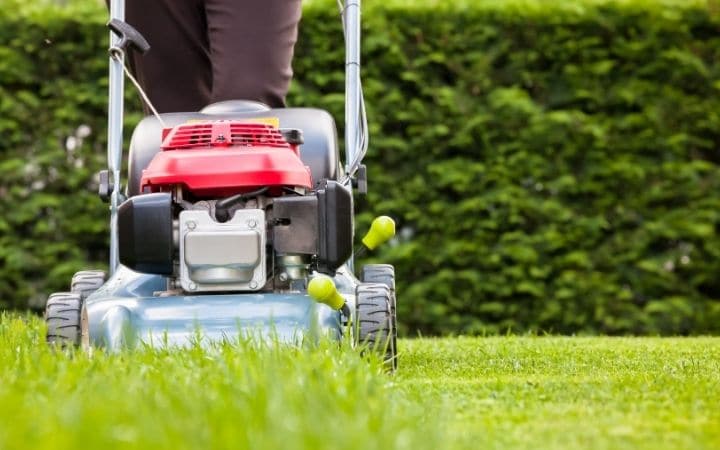What Height Should I Cut My Grass? | Fix Your Measurement

Did you know that cutting is a need to grass? It is like “pitching” your yard or garden grass for rugged growth. A lot of people have these questions in mind when it comes to cutting grass. What height should I cut my grass? Does every specific type of grass have a height that is ideal for its cutting? To what extent is the changing seasons and global location of effect with grass cutting?
Well, this post will clear out air in all those questions, In general, two and a half inches is the optimal grass level to cut to. Why is it so? Cutting grass is done to stimulate grass growth and also enables the leaves to spring out greener and healthier. Read through to get more handy information.
Grass Cutting Cycle
Cutting grass generally tends to follow a routine. With a cycle, you can easily keep in mind and master with ease. I will demonstrate the cycle using low-use grass. And you have to bear in mind recommended cutting heights for your grass type.
-
At the beginning of spring, raise height to 1 ½ inch.
-
As it gets warm in spring, lower grass height to ¾ inch.
-
If the summer is dry, raise the height to 1 ½ inch.
-
Early autumn growth picks and lowers your grass height to ¾
-
You can level up your height for the few year’s final cuts to 1 ½.
General Lawn mowing heights
-
For those lawns that are ornamental without ryegrass, 0.3 inches to a three-quarter inch or 1 to 2 centimeters.
-
For low use lawns without or with no ryegrass, ¾ inch to one and a ½ inch or 2 to 4 inches.
-
Weighty uses rye lawns, 1 to 2 inches or 2.5 to 5 inches.
-
For the shady places, increase 15% to the lawn mowing height.
-
Slopes dry quickly, hence when it’s too viable, increase the height with a 50% increase.
-
When your grass has moss, cut at least ½ inches above the moss level.
-
Keep your cutting levels to the maximum permissible in times of stress. This is when it’s extremely dry and hot or very wet.
-
More height when in doubt will be a better route to cut the grass.
-
Shady grasses should be cut a little high up to grow better.
Grass types and their cutting ranges in a different season
What height can I cut my grass, given the grass type? Let’s look at the most common grass types and their ideal cutting heights. The height to which you should cut your grass tends to vary because grass demands are diverse. Even if the grass falls in the same group type, they can be of different varieties. It is essential to know the ideal level of cutting your specific grass. Do not copy what you see from your neighbors.
Cutting grass height varies with the specific type of grass
The ideal height is highly dependent on several factors. These include grass type, growing conditions, and the season to which grass is exposed to. Further consideration should be given to the drainage, sunlight, or shedding to which the grass is subjected.
For warm-season
-
Buffalo trim down up to 1.5 inches minimum and 4 inches maximum.
-
Bermuda trims down up to 0.5 inches to 2.5inches.
-
Bahia trims down up to 2.5 inches to 4 inches.
-
Centipede trims down up to 1 inch to 2.5 inches.
-
St Augustine trims down up to 1 inch to 3 inches.
-
Zoysia trims down up to 0.5 inches to 3 inches.
-
Kikuyu grass trims down up to 1 inch to 5 inches.
You should cut your grass to the top inches recommended for your grass type in summer. You will need your grass to survive in extreme heat and dry weather conditions. Hence the need to give it that high mowing minimizing the stress on your grass. Cutting grass up to the maximum shown inches is also done to remove dead blades in early spring. Wondering if you can always remember these inches? When you forget measurements and want to cut your grass in the hot season, remember to keep your mower set at a higher wheel. And when you repeat the process, maintain that height until its cold season.
For the Cool Seasons
-
Fine Fescue trim to 1.5 inches to 4 inches.
-
Kentucky bluegrass trim to 0.75 inches to 3.5 inches.
-
Perennial ryegrass cut, leaving 0.75 inches to 2.5 inches.
-
Tall fescue trims down to 1.5 inches to 4 inches.
During the cold season, one height does not have to be adhered to through the season. When in cooler seasons, you can generally mow the lawn from two and a half to 3 inches or between that ranges. Cutting your grass when it’s around three and a half inches is what will be ideal. Generally, for the cool seasons, it’s ideal for cutting grass as high as possible. This will promote the healthy growth of grass.
Let’s see an experts video
What grass do experts say about cutting grass to seasons?
Experts recommend cutting grass to 3 inches during summer and spring. This is so because extra shading that comes from taller grass will inhibit crabgrass weed. In the fall, frost will kill the crabgrass. And you can start cutting your grass to two and a half inches in height. Seasons cannot be ignored when it comes to ideal heights for cutting grass. These should be your guide to ideal cutting sizes. Also in winter or spring, cut your grass more often at least once a week. But ensure your grass can recover with ease from frequent low cutting.
Important things to note when changing cutting heights
When changing cutting heights, follow the recommended stages. When you are lowering your grass, following the stages is very crucial. Two stops are very vital on your height set up when shifting from summer to early autumn. You have to cut one set low for both mows and then make that last lowering fine-tuning.
Ensure your grass is not moist and high up to avoid stressing your mower. This process can only be done with ease if the mower remains stress-free in dense grass, cut on the current setting, and then lower the grass after two or a day later.
Grass cutting Habits to Embrace
There is a need to observe and give grass a cut as appropriate and required. Leaving your grass growing beyond recommended heights between mowing is highly destructive. Creates a habitat for insects like mosquitoes and critters such as snakes, voles, and mice. Long grass will make the grass cutting process a pain.
Grass Cutting Habits Not to Embrace
A lot of people want grass cutting to be a once-off thing. And hence they choose to cut grass as low as the mower permits. Yes, it saves you time and energy, but it’s very costly to your grass. It exposes your grass to weed attacks, heat, and drought effects. It will never outgrow to its full potential. And you will miss out on the health and beauty that grass can give to your surroundings.
Weed Type Also Affects Grass Cutting Levels
Weed type is an aspect of concern before finalizing what grass height to keep. Crabgrass strives for space with your grass in summer and spring. With this type of weed, mowing adjustments should be made during the season. This means that even though two and a half inches is what’s ideal, change becomes unavoidable.
Importance of Maintaining Proper Grass Height
By letting the grass grow tall, you eliminate that opportunity of growing healthier grass. It is that healthy grass that will make your lawn look both attractive and more nourishing. It is also a way of managing undesired grass and weeds from growing, promoting the desired grass’s growth. For instance, if you cut fescue grass higher, the Bermuda grass, which is a low growing, will be discouraged. Also it is easy to cope with changing seasons and manage weeds better if you give the grass its idea level of cut.
Do you need a grass cutting schedule to maintain grass height?
You will need to cut your grass at least once a week when there is rapid grass growth. However, the grass tends to speak for itself, based on how it attains its growth. For example, there is more grass growth in the rain season, and grass mowing cannot be even with a dry season. Whenever you mow, never go beyond mowing a third of the grass height. This means when you are planning to mow, discover the height that is ideal for your turf. And then let it grow longer by a third, and then you can cut. In spring, cut your grass more often. This helps to obstruct growing winter weeds, thus promotes grass growth. Whatever route you decide to take cutting grass, you have left enough leaf for healthy grass.
In Conclusion
After reading through this post, I’m sure all your answers have now cleared according to the type of grass you have, as well as your location. Grass cutting cannot be a pain, and grass should grow, giving out the beauty outlined by suppliers. Be fully aware of the many factors considered in determining grass cutting levels outlined in this article. Seed suppliers and local offices can assist you with accurate information on seasonal height shifts.

Kazi Taslim
Editor
Poweredgrip ensures that an expert team of writers provides you with excellent, unbiased informational content. We are dedicated to giving you the most up-to-date and smoothest information possible. We share incomparable tips and tricks that give you awareness and confidence when making your buying decisions. Our team is enthusiastic, dedicated, and hardworking. Kazi Taslim is the editor and head of our experienced writing team.
Related Post
Lawn Mowing Etiquette | How to Be Social Neighbor
You have probably heard about etiquette in terms of having good table manners, greeting others, and so forth. But, are there do's and don'ts when it comes to start mowing lawn? Yes, there are some guidelines you ought to follow when you cut your grass to make sure you...
Fall Lawn Care | Essential Fall Lawn Care Tips
Fall has come with its cool weather, and you do not know how to maintain your lawn to be healthy and strong. You really want to improve your landscape's appearance, and having a lush lawn all year round is your goal. If that is the case, you do not have to worry. Fall...
Benefits of Mulching | Tips on Mulching Grass Clippings
When starting to cultivate your interest in gardening, you will constantly be looking for ways to improve your plants. You could be curious if getting dirty from handling the mulch is worth it. Well, you have searched in the right place at the right time as well. In...
Winter Lawn Care | Basic Tips of Winter Lawn Care
Winter is characterized by extreme weather conditions that can stress your lawn, making winter lawn care important. Cold and dry spells are likely to reduce the growth rate of your lawn. Most grasses enter dormancy during this cold season. Also, to make matters worse,...
Best Time to Dethatch Lawn | Lawn Dethatching Tips
We all see lawns in parks or around buildings such as a house, office, apartments, or commercial premises. Gardens provide an enticing look, and people keep and maintain lawns for the scenic or recreational feel. However, this beautiful green requires a lot of work...
Lawn Mowing Safety Tips | To Know Before You Mow
Mowing your lawn is one of those "macho" chores that are generally regarded as masculine. The whole idea of crank starting the mower's petrol engine and getting all sweaty pulling and pushing it forth makes one feel invincible. "What could really go wrong?" you might...







Trackbacks/Pingbacks